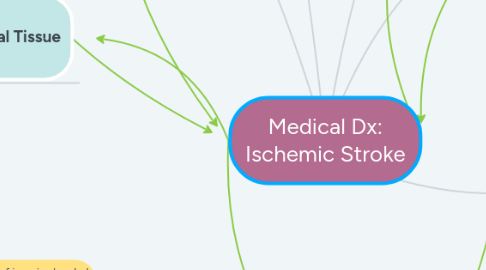
1. Hx of: Hypertension
2. Hx of: Transient Ischemic Attacks (TIA)
3. Nursing Dx #1: Ineffective Cerebral Tissue Perfusion
3.1. Assess/monitor neurological status frequently and compare with baseline
3.1.1. Patient presented upon admission 4/17 left facial droop and slurred speech with left upper extremity drift. Patient stated that left sided weakness is chronic.
3.1.2. Patient presented in the ICU 4/19 with aphasia, forgetfulness, and impulsiveness.
3.2. Assess heart rate and rhythm for murmurs
3.2.1. Patient's pulses are in the 30-70 range at rest. Rhythm is noted to be irregular. S1 and S2 noted. No murmur heard.
3.3. Obtain CT scan
3.3.1. CT scan revealed right hemispheric stroke
3.3.1.1. Administer stool softeners as indicated
3.3.1.1.1. Administered docusate orally 100 mg capsule 2 times daily.
3.3.1.2. Administer Alteplase (Activase), t-PA as indicated
3.3.1.2.1. Administered alteplase bolus 6.8mg IV given over 1 minute. Alteplase infusion 61mg given over 60 minutes.
3.4. Maintain bedrest and cluster nursing interventions to provide needed rest
3.4.1. Patient was able to maintain bedrest and nursing was left clustered throughout his plan of care
3.5. Assess speech, if patient is alert
3.5.1. Patient presents with expressive aphasia
4. Nursing Dx #2: Impaired Verbal Communication
4.1. Assess extent of impaired verbal communication
4.2. Assess for each kind of aphasia
4.2.1. Patient does not show any symptoms of receptive aphasia. Patient shows signs of expressive aphasia as evidenced by stuttering and slurred speech.
4.3. Give patient reasonable time to communicate effectively
4.3.1. Patient stutters and is sometimes forgetful. Redirected patient when feeling forgetful and provided patience when he was having difficulty communicating.
4.4. Ask patient to follow simple commands such as "close eyes", "raise both arms"
4.4.1. While performing my neurological assessment. Patient was asked to raise both arms and did so. Patient was asked to raise each arm individually and did so. Patient was asked to close both eyes and stick out tongue. Patient was able to follow simple commands.
4.5. Respect patient's inability to communicate effectively and refrain from saying things such as, "slow down"
5. Jennifer Owens
6. Atrial Fibrillation
7. Hx of: Coronary Artery Disease
8. Nursing Dx #3: Ineffective Coping
8.1. Assess their perception of their medical diagnosis
8.1.1. Patient expressed, "I do not know why my body is doing this to me". He explained that he underwent a stress test and everything was fine.
8.1.1.1. Taught patient that his heart is going into atrial fibrillation, which one of the chambers in the heart quivers. I explained that this causes pooling of blood and clotting. Doctor walked in and explained to him that this was more than likely a blood clot his heart had made from the pooling. The clot was then sent to his brain which caused the stroke.
8.2. Assess meaning of left sided dysfunction to patient
8.2.1. Assessed patient for residual left sided weakness. Patient was able to explain that things will have to change regarding his independent lifestyle. Patient was able to tell the nurse that his body feels normal though.
8.2.1.1. Asked patient if he has any family members to escort him around town to complete daily errands. Patient stated that he has support and that he will utilize it. Explained to patient the importance of taking anticoagulation medication to prevent further damage.
8.3. Encourage patient to express feelings including hostility, depression, denial, anger, disconnectedness
8.3.1. Patient was able to express feelings of his stroke and he related it to his son committing suicide after coming back from the military. He expressed, "I am just entirely too stressed out"
8.3.1.1. Used therapeutic communication to express empathy to the patient. Informed primary nurse of this assessment finding for followup psych evaluation.
8.4. Note if patient refers to affected side as "it" or denies affected side
8.4.1. Patient denies weakness on the left side of his body. Patient does not refer to his affected left side as "it".
8.4.1.1. Patient has little to no weakness on left side of his body. Decreased strength when squeezing my hand with his left hand.
9. Concept Map Legend
9.1. Pertinent pt hx/data
9.1.1. Nursing Dx/Problem
9.1.1.1. Assessment Findings and Evaluation of Assessment Findings
9.1.1.1.1. Interventions
